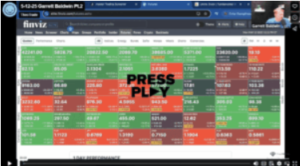I’m telling you right now! When my phone was blowing up last week with viewers panicking about that Fed announcement, I wished they all had Garrett Baldwin’s TheoTrade newsletter in their inbox! This guy breaks down complex options concepts like probability of profit in a way that even someone who still thinks buying index funds is edgy could understand! I’ve seen professional traders paying thousands for seminars that don’t deliver half the clarity Garrett gives you in one free breakdown. This is the kind of straight-talking education that turns market amateurs into confident traders! Read Garretts’ newsletter on understanding options below.
Understanding Options Starts Here
If you’re just starting to trade options — or trying to sharpen the edge on how you think about risk — this afternoon’s breakdown is for you.
We pulled back from the noise, walked through a handful of real-world examples, and revisited two of the most foundational concepts in options trading: probability of profit (POP) and the difference between calls and call spreads.
It wasn’t a technical deep-dive. The goal was clarity — showing how traders actually think about these strategies in live market conditions, and why choosing between a call and a call spread is really about understanding the behavior of the stock you’re trading.
You can watch the full session, click the replay below:
Let’s start where it all begins: understanding what “probability of profit” really means — and why it’s so critical to every trade you make.
What Is Probability of Profit?
Probability of profit — or POP — is one of the most misunderstood metrics in options trading.
At first glance, it sounds simple: the percentage chance that a trade will finish in the green. But what we focused on this afternoon was how that probability is calculated, what assumptions it relies on, and why traders should view it as a starting point, not a promise.
POP is derived from the option’s delta and the implied volatility of the underlying stock. That means it’s based on a normal distribution — assuming the stock will move in a smooth, bell-curve-like way. But markets aren’t smooth. Stocks gap. Volatility changes. So the real-world probability often differs from what the model says.
In practical terms, POP gives you a baseline for risk — a way to compare trade structures and set expectations. But it’s not static. It shifts as volatility changes and as the stock moves.
We talked about how many traders lean too heavily on POP without considering things like:
- Upcoming earnings
- Macro news events
- Volatility skew
- Liquidity in the options chain
That’s where good traders separate from the rest — by treating POP as a guide, not gospel.
What Is a Call Option?
At its core, a call option gives you the right — but not the obligation — to buy a stock at a specific price before a certain expiration date.
That’s the textbook version. But what I focused on this morning was how a call actually behaves in the real world — when it makes sense to use one, and where traders tend to get it wrong.
Buying a call is a bullish trade. You’re expecting the stock to move higher — ideally well above the strike — before expiration. And the appeal is straightforward: unlike buying the stock outright, your risk is capped at the premium you paid.
Here are a few of the cleaner setups where calls make sense:
- You want upside exposure but don’t want to tie up full capital
- You’re trading a specific catalyst (earnings, momentum, news)
- You want a defined-risk trade with open-ended reward
But this is also where most traders trip up:
- Out-of-the-money calls can expire worthless if the move doesn’t happen fast enough
- Time decay chips away at the option every day the stock stalls
- Implied volatility affects pricing just as much as direction
Calls can be effective — but only when you understand what you’re really betting on. And too often, traders are just chasing moves that already happened.
Pros and Cons of Call Options
I tried to be as clear as possible on this, because most traders don’t learn it from a book — they learn it from losing money.
Pros of buying call options:
- Defined risk: Your maximum loss is the premium you paid.
- Leverage: You can control 100 shares of stock with a relatively small upfront cost.
- Unlimited upside: If the stock moves sharply in your favor, the return potential is significant.
- Capital efficiency: You don’t need to tie up full equity for directional exposure.
But here’s where things usually go sideways:
Cons of buying call options:
- Time decay: Every day the stock doesn’t move, your option loses value.
- You have to be right on direction and timing: Being early or late is often the same as being wrong.
- Volatility premium: In volatile markets, options get expensive — and the stock might not move enough to justify the cost.
- Out-of-the-money calls frequently expire worthless: Especially when traders overestimate the size or speed of a move.
What I always try to stress is this: a call option is a tactic — not a guess. If you’ve got a reason, a timeframe, and a well-structured trade, it’s a useful tool. But it’s not something to throw at the wall and hope it sticks.
What Is a Call Spread?
A call spread is a more defined, risk-balanced version of a directional bet. Instead of just buying a call and hoping for a big move, you pair that long call with a shorter call at a higher strike — same expiration.
This limits both your upside and your cost.
In the session, I explained it like this: when you buy a call spread, you’re saying “I think this stock will move up… but I don’t need it to go to the moon.”
Let’s say you buy a 100/110 call spread. You’re long the 100 call and short the 110 call. That means:
- You profit as the stock moves toward $110
- Your maximum gain is capped at the width of the spread minus the premium paid
- Your maximum loss is the premium you paid to open the trade
You’re giving up unlimited upside in exchange for a lower cost and a higher probability of hitting your profit target — especially in rangebound or moderately bullish setups.
This structure also helps in high-volatility environments, where outright calls can get expensive. The short leg of the spread helps offset the premium, making it a more efficient way to express a view.
Pros and Cons of Call Spreads
Call spreads solve a few problems that naked calls create — but they also come with trade-offs. I laid those out clearly during the session so traders could see when this structure actually gives you the edge.
Pros of using call spreads:
- Defined risk and defined reward: You know exactly how much you can lose and how much you can make.
- Lower cost than buying a call outright: The short call offsets part of the premium you pay.
- Higher probability of profit: Because your breakeven is lower and the trade doesn’t require a huge move.
- Efficient use of capital: You reduce exposure and still maintain directional upside.
Cons to keep in mind:
- Capped upside: Your profit is limited by the width of the spread.
- More complexity: Two legs mean more moving parts — pricing, execution, and exit.
- Can be hard to adjust: Once you’re in a defined-risk spread, rolling or scaling requires more planning.
- Short leg can still cause problems if the trade moves deep in the money too quickly.
The main point I made was this: call spreads are better for traders who want to define risk upfront and are targeting a reasonable, not explosive, move. They’re not meant to catch every dollar of upside — they’re meant to improve consistency and balance risk/reward.
Final Takeaways
Options trading doesn’t have to be overwhelming — but it does require structure.
If you walk away with one thing from today’s session, let it be this: successful trading comes down to defining your risk, understanding your probabilities, and picking the right structure for the kind of move you’re targeting.
Whether it’s a straight call or a spread, your edge isn’t just in the setup — it’s in the planning.
We’ll continue building on this in future sessions. For now, keep these concepts close. Review the slides. Rewatch the breakdown. And make sure the next time you click “buy,” you know exactly why.
Stay positive,
Garrett
Spread the love
Related Articles:







